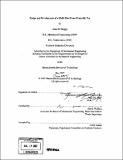| dc.contributor.advisor | David Wallace. | en_US |
| dc.contributor.author | Skaggs, Alan M. (Alan Michael) | en_US |
| dc.contributor.other | Massachusetts Institute of Technology. Dept. of Mechanical Engineering. | en_US |
| dc.date.accessioned | 2008-03-27T18:26:31Z | |
| dc.date.available | 2008-03-27T18:26:31Z | |
| dc.date.copyright | 2007 | en_US |
| dc.date.issued | 2007 | en_US |
| dc.identifier.uri | http://hdl.handle.net/1721.1/40946 | |
| dc.description | Thesis (S.M.)--Massachusetts Institute of Technology, Dept. of Mechanical Engineering, 2007. | en_US |
| dc.description | Includes bibliographical references (p. 59). | en_US |
| dc.description.abstract | The goal of this research was to design and develop a working prototype of a new toy for Hasbro®'s Nerfe line of foam projectile toys. Several years ago, Hasbro approached the MIT CADlab about developing a new method for firing Nerfe foam balls. The hope was that a new approach would be generated from which a new platform of products could be developed. The result of the initial work was the development of Hopper Popper ActivationTM, which uses a bistable rubber spring to fire Nerf foam balls. Due to its novel nature and the simplicity of its design, Hopper Popper Activation has since been integrated into a single projectile toy named the Atom BlasterTM, which reached the market in early 2007. Following the success of this project, Hasbro requested that a multi-shot projectile toy be developed that makes use of Hopper Popper ActivationTM, so that it may extend the platform of toys which use this new firing mechanism. This thesis follows the product design process that led to the development of the Multi-Shot PopperTM, which incorporates Hopper Popper ActivationTM into a toy blaster capable of storing and rapidly firing multiple foam ball projectiles. In addition to using Hopper Popper ActivationTM, the Multi-Shot PopperTM was required to fulfill several other requirements, including specific safety and performance specifications, while still remaining a fun and enjoyable toy. The design team created a series of iterative sketch models to test different mechanisms and methods of accomplishing the stated functional requirements. At each stage of the process, the successes and shortcomings of the current model were assessed and small scale brainstorming sessions were held to generate new concepts. These new concepts were combined with the successful features of the previous models until a final alpha-prototype was created which meets the customer and user requirements. | en_US |
| dc.description.statementofresponsibility | by Alan M. Skaggs. | en_US |
| dc.format.extent | 59 p. | en_US |
| dc.language.iso | eng | en_US |
| dc.publisher | Massachusetts Institute of Technology | en_US |
| dc.rights | M.I.T. theses are protected by
copyright. They may be viewed from this source for any purpose, but
reproduction or distribution in any format is prohibited without written
permission. See provided URL for inquiries about permission. | en_US |
| dc.rights.uri | http://dspace.mit.edu/handle/1721.1/7582 | en_US |
| dc.subject | Mechanical Engineering. | en_US |
| dc.title | Design and development of a multi-shot foam projectile toy | en_US |
| dc.type | Thesis | en_US |
| dc.description.degree | S.M. | en_US |
| dc.contributor.department | Massachusetts Institute of Technology. Department of Mechanical Engineering | |
| dc.identifier.oclc | 212624827 | en_US |
